We’ve all been there you open the freezer spot that frozen pack of chicken, and realise dinner starts in an hours, you might think. may be i can just leave it on the counter for a bit or hot water will make this faster right
Not so fast
The way you defrost chicken can be the difference between a safe delicious meal and a risky mistake that could land you or your family with food poisoning. According to the U.S Department of agriculture USDA millions of americans get sick each year, From improper food handling and unsafe thawing practices area big reason why?
So let’s talk about what safe what’s not and how to thaw chicken the right way witout compromising taste or safety
Wondering how long defrosted chicken actually stays safe in the fridge? Check out our complete guide — How Long Does Defrosted Chicken Last in the Fridge – for USDA-approved time limits and storage tips.
🧠 Why Defrosting Chicken Properly Actually Matters
When chicken freezes the bacteria on it don’t disappear – they simply go dormant. Once it starts to thaw and warm above 40°F (4°C), those bacteria wake up and multiply fast
The USDA calls this temperature range the Danger zone (40°F–140°F) – the sweet spot where bacteria like salmonella and campylobacter can double every 20 minutes
Now, here’s the kicker cooking kills bacteria but some bacteria produce heat-resistant toixns while growing That means even if you cook the chicken later, Those toxins can remain and cause foodborne illness
So yes defrosting chicken safely isn’t just about avoiding spoiled meat it’s literally about avoiding food poisoning
✅ The 3 Safe, USDA-Approved Ways to Defrost Chicken
You’ve got three reliable science backed options pick whichever fits your schedule.
1. Thawing Chicken in the Refrigerator (Best for Planning Ahead)
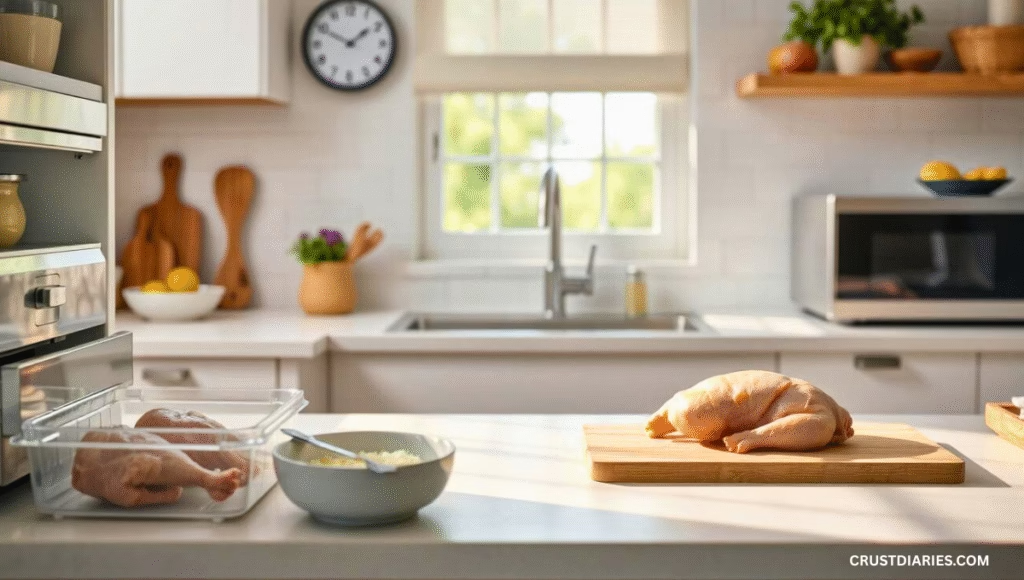
This is the safest, most foolprood method:
How to do it:
- Keep the chicken in its original packaging or place it in a leakproof plastic bag
- Set it on a plate or tray on the bottom shelf of your fridge to prevent any juices from dripping onto other foods
- Keep your refrigerator at 40°F (4°C) or below
How long it takes:
- Small cuts like breasts or thighs: about 24 hours
- A whole chicken: roughly 24 hours per 4-5 pounds
Why it’s the best method:
- The chicken stays out of the danger zone the entire time. You can also refreeze it safely if you change your mind before cooking
After thawing:
- The USDA recommends cooking or refreezing the chicken within 1-2 days
Pro Tip: plan your meals ahead defrost what you’ll cook tomorrow not tonight
2. Thawing Chicken in Cold Water (Faster but Requires Attention)
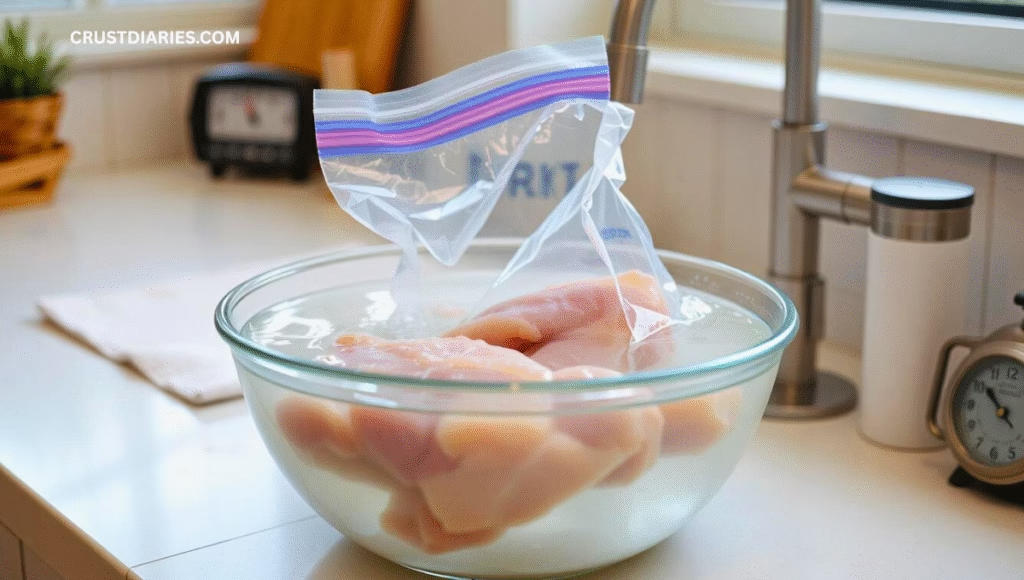
If you forget to take the chicken out last night, this method is your next best option
How to do it:
- Seal the chicken in a leakprrof plastic bag to aviod waterlogging and cross contamination
- Submerge it in cold tap water
- Change the water every 30 minutes to keep it cold
How long it takes:
- Boneless chicken breasts: about1-2 hours
- Whole chicken: 3-4 hours, depending on size
After thawing:
You must cook the chicken immediately you cannot safely refreeze or refrigerate it afterward
Pro Tip: keep a kitchen timer handy so you don’t forget to swap the water- that’s what keeps it safe
Thawing Chicken in the Microwave (For Last-Minute Cooks)
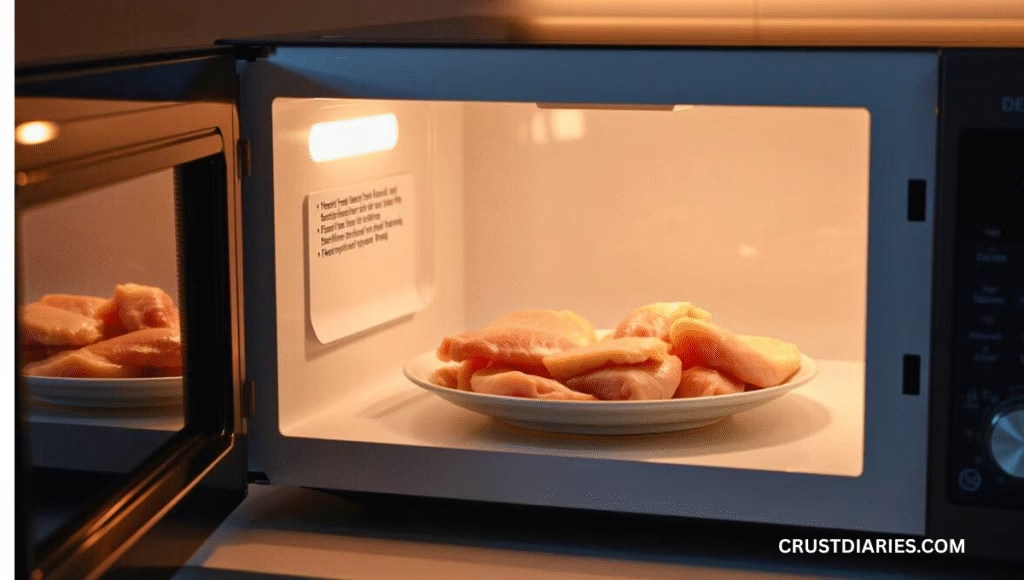
We’ve all had those days when time is short. the microwave can be your savior- if you use it correctly
How to do it:
- Remove any packaging and plavce the chicken on a microwave safe plate
- Use the defrost setting following your microwave weight instructions
- Rotate or flip the chicken every few minutes for even thawing
Important:
- Microwave tend to thaw unevenly some areas start cooking while others stay frozen – and those warm spots are perfect for bacteria
So, once it’s thawed cook it immediately don’t let it sit on the counter for a bit
Pro Tip: if yoy notice some cooked edges. Thats’s okay- just procees straight to cooking
Unsafe Chicken-Thawing Habits to Stop Immediately
Unfortunately many quick hacks you see online or hear from family members can actually make chicken unsafe here are the top offenders
❌ 1. Leaving Chicken on the Counter
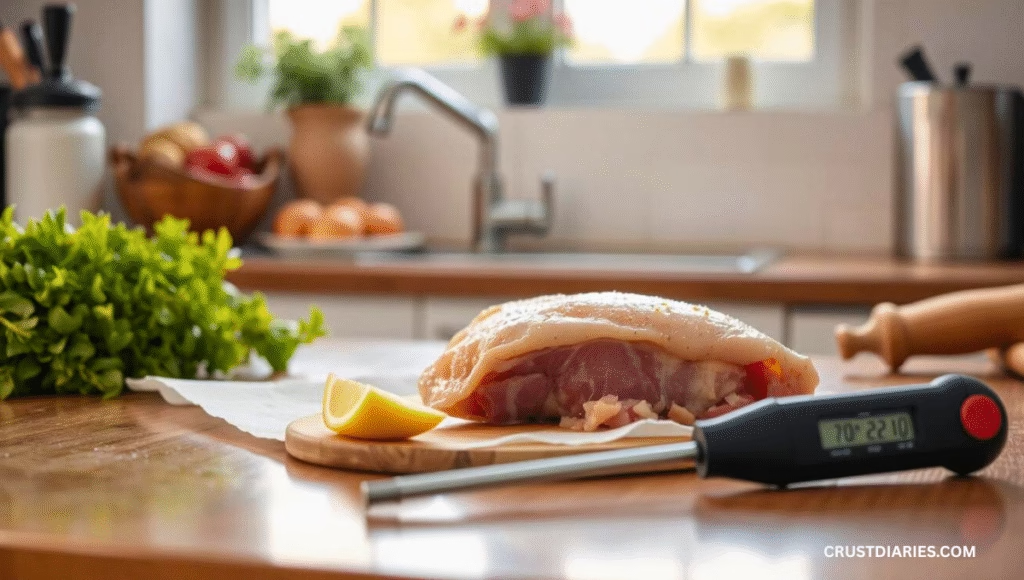
This ones a classic- and one of the wrost
- Leaving chicken at room temperature, even for an hour or two pushes the surface temperature in to the danger zone long before the center thaws
- It may look harmless but bacteria are already multiplying on the outer layer – and no you can;t cook it off
USDA warning: never thaw meat or poultry on the conter or in warm places like the oven or near a vent
❌ 2. Using Hot or Warm Water
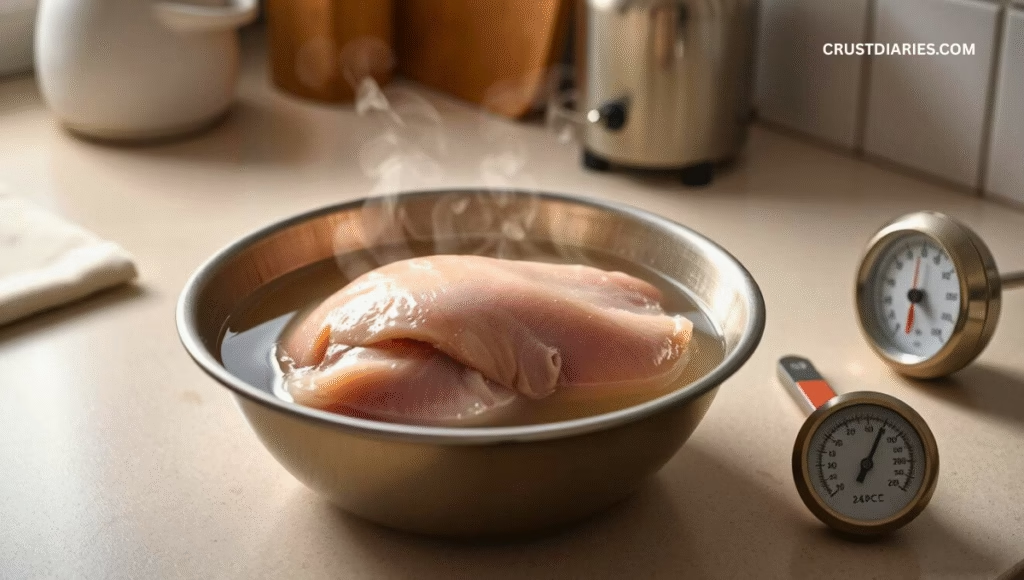
Some people try to speed things up with hot water thinking it’s safe as long as i cook it soon- but hot water creates the perfect bacterial party on the outside while the inside remains icy
- It also starts to par-cook parts of the chicken runing both the texture and safety
- If you want to use water stick with cold and refresh it every 30 minutes
❌ 3. Thawing Chicken Overnight in the Sink
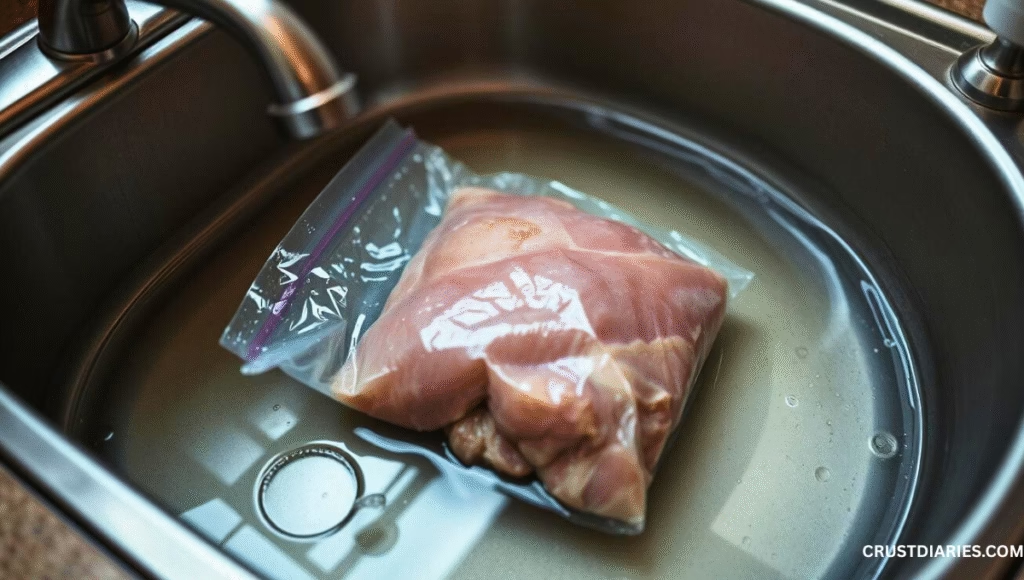
Even if you start with cold water, leaving it overnight means the water temperature will gradually rise as it sits. Once it hits 60°F or higher, you’re squarely in the danger zone
- This one’s sneaky because the chicken might still feel cold but it’s already unsafe to cook
❌ 4. Leaving Chicken on Metal or Wooden Surfaces
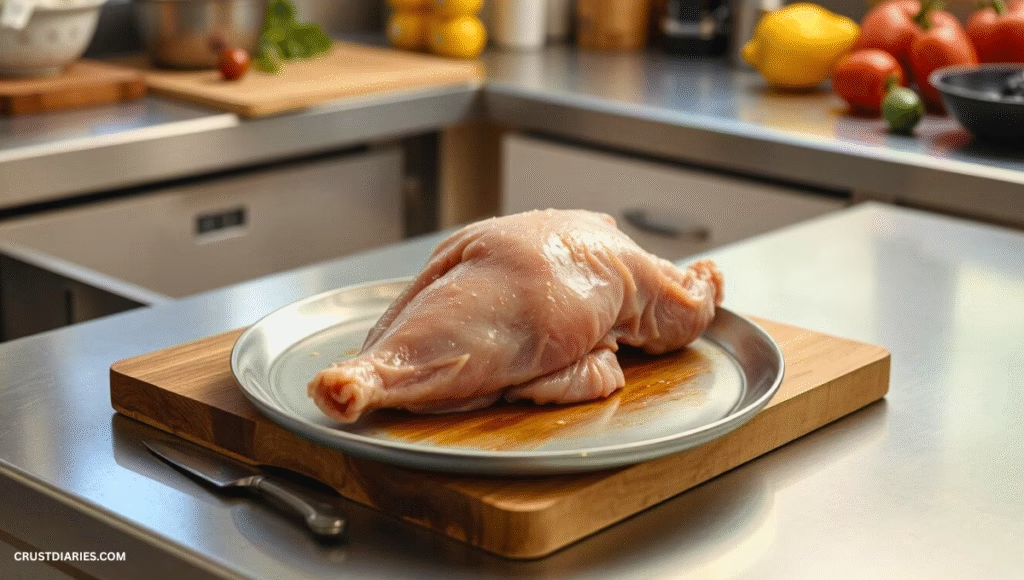
Placing frozen chicken directly on metal, plastic or wooden counterops might seem convenient, but it’s risky
- Metal warms fast, thawing the outside unevenly wood absorbs juices which can contaminate your kitchen even after cleaning
If you must set it down use a plate or tray that can be sanitized easily
🍗 Bonus: Safe Defrosting for Cooked or Leftover Chicken
If you’ve already cooked the chicken and froze it, thawing rules are a little deifferent:
- In the fridge: Still the best option- safe for up 3-4 days after thawing
- In the microwave: Also fine, but again reheat immediately to 165°F
- Never on the counter: Same danger xone applies
Pro Tip: label leftover chicken with the freeze date- freezer amnesia is real and you don’t want to guess
🧽 How to Clean Up After Thawing Chicken
Even if you follow all the safe thawing steps, It’s easy to spread bacteria around your kitchen if you’re not careful afterward
Here’s a quick checklist:
- Wash your hands for atleast 20 seconds after handling raw chicken
- Use hot, soapy water to clean cutting boards, countertops amd sinks
- Never reuse a plate or utensil that touched raw chicken for cooked food
- Disinfect anything that might have vaught drips- fridge shelves towels or sponges
A few extra mintues of cleaning can save you hours of regret later
🧂 Food Safety Pro Tips from U.S. Experts
- Use a food themometer: chicken is safe to eat only when its internal temperature hits 165°F (74°C).
- Plan defrosting around your schedule: If you’re cooking dinner at 6 p.m, move the chicken to the fridge the night before
- Keep raw and cooked foods separate: Use different cutting boards and utensils
- Don’t rinse raw chicken: washing it spreads bacteria around your sink area. COoking is what kills them
❓ Common Questions (U.S. Audience FAQs)
Q; Can i refreeze chicjen after thawing it in the fridge?
- ✅Yes- as long as it was thawed in the fridge and hasn’t been sitting more than 1-2 days. The quality may decline slightly but it’s safe
Q; What if i forget to cook thawed chicken after two days?
- 🚫If it’s been more than 48 hours in the fridge, it’s safest to toss it. Don’t risk it- bacteria grow even at fridge temperatures, just slowly
Q: Can i thaw chicken in its packaging?
- If it’s a vaccum- sealed or plastic- wrapped pack yes- but make sure the bag doesn’t leak. cardboard or foam trays can absorb water and leak bacteria
Final Thoughts
Thawing chicken safely isn’t complicated- it’sjust about controlling temperature and time if you remember one rule, let it be this: Keep it below 40°F until you’re ready to cook
Whether you go slow with the fridge, steady with cold water or qucik with the microwave you’ll protect your family and keep your chicken juicy flavorful and safe
Skip the counter shortcuts the extra planning pays off in peace of mind and fewer upset stomatchs
Because when it comes to chicken a little patience goes a long way- and your dinner guests will thank you for it


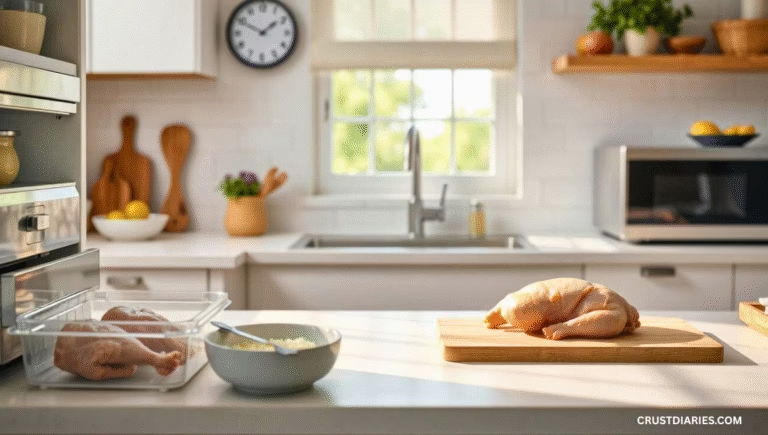

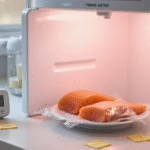
Pingback: How Long Does Defrosted Chicken Last In The Fridge?[USDA Tips]